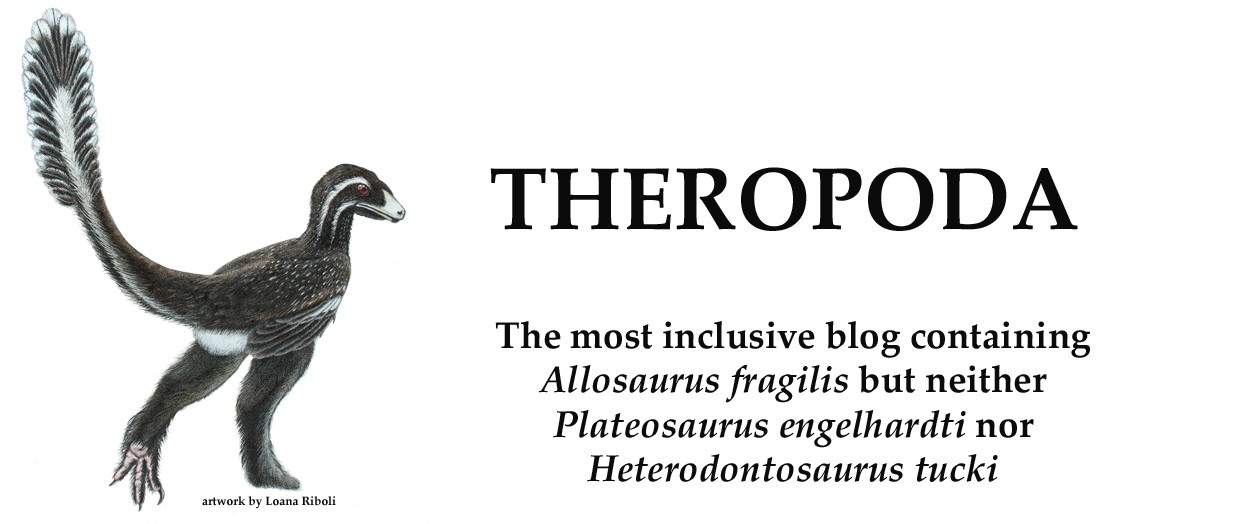Ho trovato questa simpatica foto di una razza di piccioni selezionati per avere delle vistose penne metatarsali (!) e colorazione nera e bianca. Si credono di essere degli Anchiornis? Notare l'inclinazione delle penne metatarsali, probabilmente quella più probabile anche nei taxa fossili per permettere di deambulare e sedersi.


Chissà se quelle penne metatarsali compromettono almeno in parte il volo di questi piccioni...
RispondiEliminaDai miei remoti ricordi della piccionaia della Nonna i piccioni di razza romagnola o imbastarditi con tale razza(cha hanno delle penne metatarsali, anche se più piccole di questi, che forse sono ungheresi) volavano meno bene ed erano meno "puliti" dei normali colombacci.
RispondiEliminaMa i romagnoli erano lì per bellezza, mentre i colombacci finivano in padella...
La selezione artificiale dei colombi è fotissima, forse seconda solo a quella dei cani, esistono centinaia di razze. Non abbiamo mai avuto dei piccioni viaggiatori, ma da quello che so non hanno mai piume metatarsali, e sono dei volatori eccezionali, secondi solo ai falconiformi in velocità.
Erodoto
Probabilmente le penne di questi piccioni non permettono un volo efficiente come nei piccioni normali. Ciò è abbastanza ovvio, dato che è evidente la natura "ingombrante ed estetica" di quelle penne.
RispondiEliminaNel caso la domanda fosse legata ai theropodi fossili con penne metatarsali, _Anchiornis_ non ha vessillo asimmetrico nelle penne e quindi non le usava per volare. _Microraptor_ non volava in senso stretto, ma probabilmente planava. In quel caso, le penne metatarsali hanno vessillo asimmetrico, e quindi contribuivano alla aerodinamica.
La ricomparsa di queste penne metatarsali potrebbe essere un esempio di atavismo?... 'geni dinosauriani' risvegliati e riselezionati dall'uomo... no?
RispondiEliminaI think the case in Anchiornis is far less problematical than the case of Microraptor.
RispondiEliminaThe tibial and metatarsal feathers of Anchiornis seem quite flimsy structures and I would think those things would definately bend under the weight of the animal. Also since the feathers of Anchiornis are symetrical there is no airfoil to consider. Microraptor is the real problem case.
But it seems that many people suffer from the same problem while interperting these structures. And that is they seem to think that these feathers were always extended. If these things worked as airfoil there must have been a way to protect them, there must have been someway to fold them. Taking that in to consideration it is especially interesting that Microraptor has really long mt 5 with expanded distal head that almost seems like the distal head of typical pedal phalange. I think there must be some connection with Microraptors unusual mt5 and the leg feathers. If the feathers could be folded there is no sitting problem as proposed by you.
I also find your pidgeon example rather unconvincing. That breed was produced by selective breeding by man not by nature. We can produce all sorts of things with all sorts of structures that you wouldn't normally find in nature becaue it is we who controll the sellective pressures as we have freed the population from natural pressures and subjected the population under our own whimsical selection.
Non credo, come dicevo la selezione artificale tra i colombi domestici è fortissima, e la selezione artificiale può rendere possibile ciò che la selezione naturale rende improbabile.
RispondiEliminaMa sull'atavismo lascio volentieri la parola a Cau e agli altri scienziati.
Erodoto
Crap, forgot to add the intro. That was my comment on the dinogoss blog on the very same issue, and I just copy pasted it here as it tells pretty much my views of the subject.
RispondiEliminaMentre scrievo si è aggiunto il commento d Sinkkonen; va da se che la mia risposta era per Prolagus...
RispondiEliminaErodoto
Ville,
RispondiEliminaI quoted these pigeons ironically (as marked by the topic "frivolous"): being created artificially, having a different hindlimb anatomy from a basal deinonychosaurs, I don't consider these birds as model for interpreting the 4-winged maniraptorans.
I wrote that _Anchiornis_ lacks aerodinamic feathers: that taxon is not problematic.
Considering _Microraptor_, the biplane model seems to me the best explanation available, pending new studies. Your consideration about MT V is interesting, and could be correct. Once, I also considered the hypothesis that the pronounced lateral caudal flange of deinonychosaurian Mt IV as the anchoring site for metatarsal feathers. Interestingly, that process is reduced in derived troodontids and eudromaeosaurs, maybe suggesting reduction of these feathers in larger and more ground dwelling taxa.
Oh I'm sorry. I did not notice that you had marked the post as frivolous.
RispondiEliminaThe flange is interesting. maybe it also served as insertation area for small muscles controlling the extension and folding of the feathers?
In absence of modern analogue, it's difficult to say.
RispondiEliminaIn my opinion, the elongation of MT V, its bowed shape (recalling the bowed metacarpal II that in maniraptorans bears remiges!) and distal expansion contacting MT IV at the level of the lateral flange of the latter may indicate an expanded site for feather anchoring. Given that the mt IV flange probably was the site for pedal flexor muscles, it's possible that feather movement was linked to digital flexion/extension. For example (it's only an hypothesis): the contraction of the muscle running along the metatarsal flange (during digit flexion) would generate feather folding.
Erodoto,
RispondiEliminaio non rientro nella categoria "scienziato", che non amo. Sono un naturalista.
Per la questione atavismo. Non credo che quello sia il caso. Mi pare più una mutazione selezionata artificialmente. Alte specie di uccelli hanno forme con penne o piume metatarsali, e non penso sia necessario invocare l'atavismo. A differenza di altri, io non concordo con l'ipotesi che la linea degli uccelli abbia attraversato uno stadio "a 4 ali"). Archaeopteryx non mostra penne così sviluppate nei metatarsi, ma solo penne tibiali. La mia idea è che le lunghe penne metatarsali siano una caratteristica solo dei deinonychosauri e non di tutti i paraviali basali. Parafrasando Holtz: "deinonichosaur paleobiology, more than just bird origins".
tempo fa mi nacque un inseparabile con una mutazione del genere. per fortuna in forma leggera...però era curioso
RispondiEliminacla